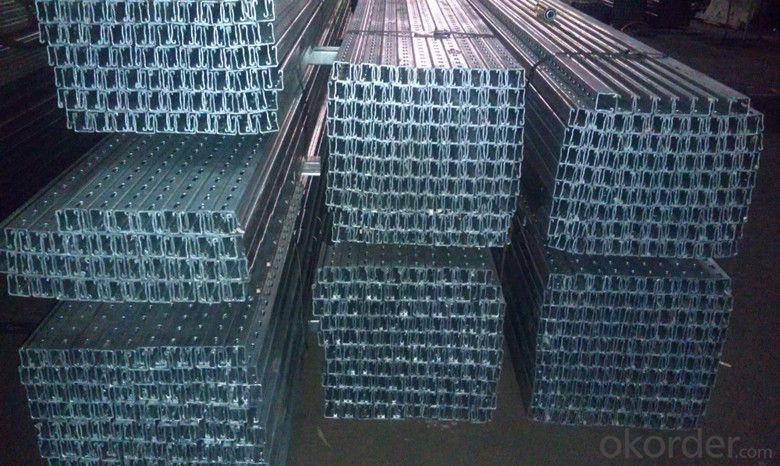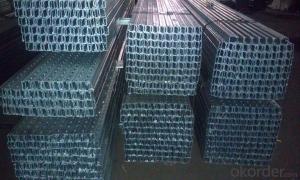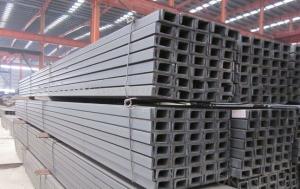C Steel Profile Channel Chinese supplier
- Loading Port:
- Shanghai
- Payment Terms:
- TT OR LC
- Min Order Qty:
- 2000 PCS
- Supply Capability:
- 40000 PCS/month
OKorder Service Pledge
OKorder Financial Service
You Might Also Like
Chinese supplier C Steel Profile Channel Details
Standard: | AISI,ASTM,BS,DIN,GB,JIS | Dimensions: | 41*41,41*21, 41x62,41x82 | Grade: | Aluminum |
Place of Origin: | China (Mainland) | Perforated Or Not: | Is Perforated | Model Number: | HM100t |
Shape: | C Channel | Application: | cable support |
Packaging & Delivery
Packaging Detail: | Packaging Detail: PALLET AS CLIENT REQUIREMENT Delivery Detail: 10-20DAYS |
Delivery Detail: | 20 Days |
Chinese supplier C Steel Profile Channel Specification
Strong anti-rusting
Heavy duty qualified
Free samples provided
Chinese supplier C Steel Profile Channel Description
Light-duty, medium-duty and heavy-duty can be qualified.
Any environmental condition can be applied due to its wide rang of surface treatment and materials options
It has a good ventilation.
Chinese supplier C Steel Profile Channel Pictures


- Q:Are steel channels suitable for architectural feature elements?
- Yes, steel channels can be suitable for architectural feature elements. Steel channels are strong, durable, and versatile, making them suitable for various architectural applications. They can be used to create unique and visually appealing architectural elements such as decorative screens, columns, beams, and facades. Additionally, steel channels offer great structural support, allowing architects to design intricate and complex feature elements.
- Q:Difference between steel channel and channel steel!
- It shouldn't make any difference, but I'm not sure.
- Q:28a difference between channel steel and 28b channel steel
- 180×70×9 18 # B 23200×73 * 7 20 #的22.637200×75×9 20 # B 25.777* * 220 77 7 22 #的24.999220 * * 79 9 22 # B 28.453* * 240 78 7 24 #的26.86240 * * 80 9 24 # B 30.628
- Q:Can steel channels be used in the automotive parts manufacturing industry?
- Yes, steel channels can be used in the automotive parts manufacturing industry. Steel channels are commonly used in this industry due to their strength, durability, and versatility. They can be used in various applications such as frame components, structural supports, and chassis reinforcements. Additionally, steel channels offer good resistance to impact, corrosion, and high temperatures, making them suitable for automotive manufacturing requirements.
- Q:How do you calculate the section modulus for steel channels?
- To calculate the section modulus for steel channels, you will need to consider the geometric properties of the channel cross-section. The section modulus is a measure of a shape's resistance to bending and is used to determine the strength and stiffness of the channel. The formula for calculating the section modulus of a steel channel is: Z = (b * h^2) / 6 where Z is the section modulus, b is the width of the channel, and h is the height of the channel. First, measure the width and height of the steel channel. The width typically refers to the distance between the flanges, while the height refers to the dimension perpendicular to the flanges. Next, substitute the values of b and h into the formula and calculate the section modulus. The result will be a value representing the resistance of the steel channel to bending. The higher the section modulus, the stronger and stiffer the channel will be. It's important to note that section modulus calculations are based on assumptions of elastic behavior and linear stress distribution. For more accurate results, it's recommended to consult engineering design manuals or consult with a structural engineer who can account for additional factors such as material properties and loading conditions.
- Q:Can steel channels be used for creating staircases or handrails?
- Staircases or handrails can be created using steel channels. With their versatility and strength, steel channels are an excellent option for constructing these features. They offer structural support and stability, guaranteeing the safety of those utilizing the stairs or handrails. Moreover, steel channels can be conveniently fabricated and tailored to meet specific design needs, suiting various architectural styles. Furthermore, their durability and resistance to wear and tear make them a lasting choice for staircases and handrails.
- Q:Are steel channels suitable for use in piping systems?
- Steel channels are not suitable for use in piping systems. They are primarily intended for structural support or framing in construction projects and are not designed to withstand the pressure and flow of fluids in piping systems. Piping systems necessitate materials that are specially designed and tested to withstand high pressure, corrosion, and temperature fluctuations. Typical materials used in piping systems include steel pipes, copper pipes, and various types of plastic pipes that are specifically engineered for this purpose.
- Q:6.3# how long is the channel length?
- Standard Specification for hot rolled plain channel steel:63*40*4.8 6.3# 6.635 KG/M channel measurement theoretical weight weight calculation theory for calculation of steel kg (kg). The basic formula is: W (weight, kg) = F (basal area mm2) * L (length m) * P (density g/cm3) * 1/1000 steel density: 7.85g/cm3.63**40 *4.8 6.3# 6.635
- Q:What are the different methods for cutting steel channels?
- There exist numerous techniques for cutting steel channels, each presenting its own advantages and disadvantages. Among the most frequently employed methods are the following: 1. Sawing: This method entails the utilization of a circular saw or bandsaw to sever the steel channel. It is a versatile technique, accommodating both straight and angled cuts. Nevertheless, it can be time-consuming and may produce a coarse finish that necessitates additional processing. 2. Shearing: Shearing involves the deployment of a specialized machine called a shear to sever the steel channel. It is a swift and efficient method, yielding clean and precise cuts. However, it is limited to straight cuts and may not be suitable for thicker or larger steel channels. 3. Cutting torch: A cutting torch employs a high-temperature flame to melt and sever the steel channel. It is commonly utilized for thicker or heavier steel channels and can yield smooth and precise cuts. Nonetheless, it necessitates skilled operators and can be more time-consuming than other methods. 4. Plasma cutting: Plasma cutting employs a plasma torch to sever the steel channel. It is a rapid and accurate method that caters to both straight cuts and intricate shapes. Nevertheless, it necessitates specialized equipment and may generate a heat-affected zone that requires additional processing. 5. Waterjet cutting: Waterjet cutting employs a high-pressure stream of water mixed with abrasive material to sever the steel channel. It is a precise and versatile method that yields clean and accurate cuts in various materials and thicknesses. However, it can be costly and may require skilled operators. 6. Laser cutting: Laser cutting employs a focused laser beam to sever the steel channel. It is an exceedingly precise method that produces intricate cuts with minimal heat-affected zone. However, it can be expensive and may require specialized equipment and operators. When selecting the appropriate method for cutting, it is essential to consider the thickness, size, and complexity of the steel channel, as well as the desired finish and the available resources.
- Q:How do steel channels perform in terms of fire resistance?
- Steel channels perform well in terms of fire resistance due to their high melting point and structural integrity. They do not combust or release toxic fumes when exposed to fire, making them a reliable choice for construction in fire-prone areas. Additionally, steel channels can help maintain the integrity of a structure during a fire, providing support and preventing collapse.
1. Manufacturer Overview |
|
|---|---|
| Location | |
| Year Established | |
| Annual Output Value | |
| Main Markets | |
| Company Certifications | |
2. Manufacturer Certificates |
|
|---|---|
| a) Certification Name | |
| Range | |
| Reference | |
| Validity Period | |
3. Manufacturer Capability |
|
|---|---|
| a)Trade Capacity | |
| Nearest Port | |
| Export Percentage | |
| No.of Employees in Trade Department | |
| Language Spoken: | |
| b)Factory Information | |
| Factory Size: | |
| No. of Production Lines | |
| Contract Manufacturing | |
| Product Price Range | |
Send your message to us
C Steel Profile Channel Chinese supplier
- Loading Port:
- Shanghai
- Payment Terms:
- TT OR LC
- Min Order Qty:
- 2000 PCS
- Supply Capability:
- 40000 PCS/month
OKorder Service Pledge
OKorder Financial Service
Similar products
New products
Hot products
Hot Searches
Related keywords




























